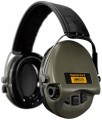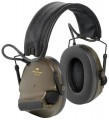Single Number Rating (SNR)
An indicator of how much decibel certain headphones reduce the level of external noise. Acoustic efficiency SNR (Single Number Rating) is the sound absorption characteristics according to the requirements of the European quality standard. A similar standard in the American style is called NRR (about it, see below).
The specified SNR value allows you to determine how much peak noise the headphones absorb. So, if this parameter is 27 dB, then the noise level that enters the user's ear is 27 dB lower than the sound level in the environment. The higher the SNR value, the more effective the hearing protection.
Noise Reduction Ratio (NRR)
An indicator of how much volume in decibels tactical headphones cut during operation. Acoustic efficiency NRR (Noise Reduction Rating) is the sound absorption characteristics according to the requirements of the American quality standard. A similar standard in the European style is called SRR (about it, see above).
NRR is an assessment of how effectively a hearing protection device can reduce ambient noise levels. If headphones are marked with the “NRR 30 dB” mark, then they can reduce the level of external sounds by 30 dB. The higher the NRR value, the more effective the tactical headphones are at protecting the hearing aid.
Audio input
Connector for connecting external audio sources to headphones. As a rule, the role
of audio input is performed by a 3.5 mm mini-Jack. Tactical headphones with an incoming audio connector provide the ability to combine sounds - both from the environment through built-in microphones, and transmitted information from external sources (for example, a walkie-talkie), which can be useful in tactical operations.
Water protection
Tactical headphones are protected from dust and moisture. This paragraph also clarifies the level of such protection in accordance with the IP standard.
The degree of protection is usually denoted by two numbers according to the IP standard. The first number corresponds to dust protection. As a rule, tactical headphones indicate their maximum ratings of “5” and “6” (dust resistance without complete closure and complete dust resistance, respectively). The second digit indicates the degree of protection against water. For moisture-resistant models
with splash protection, markings up to the number “6” are used. Full
water resistance corresponds to levels 7 (possibility of immersion under water to a depth of 1 m for half an hour) or 8 (possibility of prolonged operation under water at a depth of more than 1 m). Thus, the maximum degree of protection according to this standard is IP68, completely sealed. There are also IPX8 markings, where the first digit is not indicated - this means that the headphones have not undergone official certification for dust resistance. However, water resistance level 8 automatically entails a sealed case that is also impenetrable to dust.
Operating time
Operating time of the headphones on one set of replaceable batteries or a full charge of the built-in battery (see “Power source”).
Using this parameter, you can roughly estimate the duration of use of tactical headphones without the need to replace batteries or recharge the power source. It is also intended to compare the real capabilities of different models.
Operating temperature
The range of ambient temperatures at which the headphones can function normally. Note that if you go beyond this range, the headphones are unlikely to fail, but their correct operation in such cases is not guaranteed.
As for specific numbers, most modern models have a wide enough operating temperature range to normally withstand both severe frosts (down to about -20 °C) and hot summer heat (up to +50 °C and above). However, it is not advisable to expose even the most “heat-resistant” models to prolonged exposure to the sun: under direct sunlight, the headphone body can become very hot even in cold weather.
In the box
Additional equipment included with tactical headphones.
-
Case. Case for storing and transporting headphones. Cases are soft fabric cases: they protect the device from dust, moisture and dirt during storage and transportation. The cases are also used to store additional items such as a charging cable or replacement batteries.
— Batteries. Replacement batteries of standard size for tactical headphones with appropriate power supply. This configuration allows you to use the device “out of the box” without purchasing additional energy sources. Note that the kit usually includes elements in the form of disposable batteries, and not rechargeable batteries.
-
Audio cable. The standard equipment includes a special cable that can be used to connect tactical headphones to various audio sources or communication devices. As a rule, the supplied audio cable has ends with connectors for a mini-Jack socket (3.5 mm), however, there are other options for its implementation - it is advisable to clarify these points separately.

